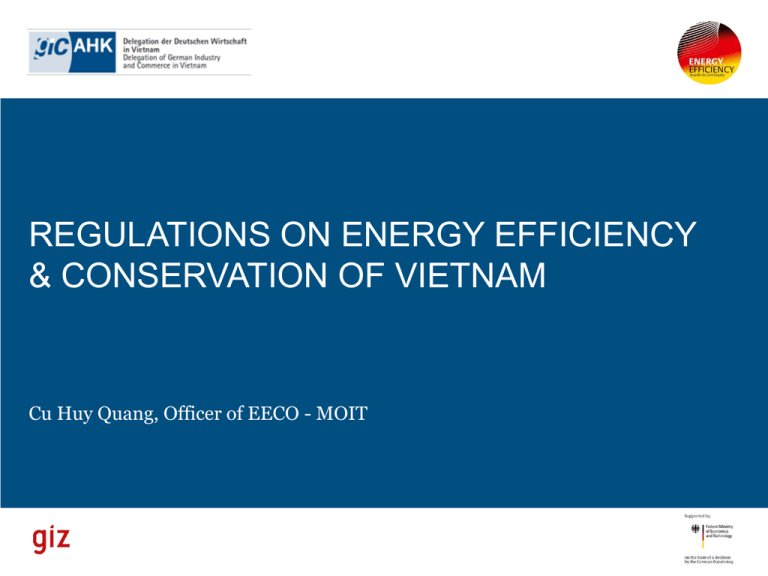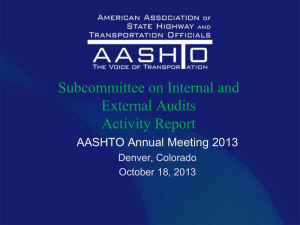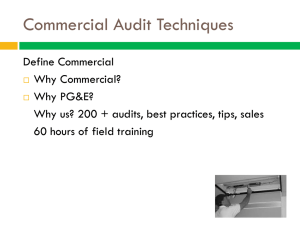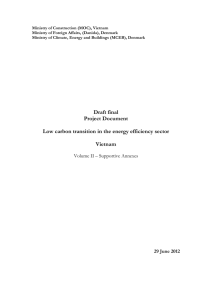Energy Managers
advertisement

REGULATIONS ON ENERGY EFFICIENCY & CONSERVATION OF VIETNAM Cu Huy Quang, Officer of EECO - MOIT Content Regulation on Energy Conservation of Vietnam Efficiency The Vietnam Energy Efficiency & Conservation Program (VNEEP) and Regulation on Energy Efficiency and Conservation of Vietnam Related Regulations LAW No. 50/2010/QH12 Decree No. 21/2011/NĐ-CP Decree No. 73/2011/NĐ-CP Detailed regulations and measures for implementation of the Law on EE&C Regulations on the penalties for the administrative violations in EE&C Circular No. 39/2011/TT-BCT Training, certification of EMs, EAs Circular No. 09/2012/TT-BCT Planning & Report on the implementation of EE&C plans; Forms of Reports. Procedures on Energy Audits, and Report Related Regulations LAW No. 50/2010/QH12 Decree No. 21/2011/NĐ-CP Detailed regulations and measures for implementation of the Law on EE&C Circular No. 39/2010/TT-BCT Training content, program, authority of energy management, energy audit certificates Decree No. 73/2011/NĐ-CP Regulations on the penalty for the administrative violation in EE&C Circular No. 07/2012/TT-BCT Energy Labeling for the energy using vehicle, appliances Related Regulations Decision No. 51/2011/QĐ-TTg issued by the Prime Minister – Approval of the List of Facilities and Equipment Required to Comply with Regulations on Energy Labeling and Minimum Energy Performance Standards. Decision No. 68/2011/QĐ-TTg issued by the Prime Minister on the List of Energy Efficient Facilities and Equipment to be equipped in the offices and organizations which using state budget. Subjects regulated by EEC Law (Articles 9, 10, 11, 12, 13, 14) (Articles15, 16, 17, 18) (Articles 19, 20, 21) (Articles 29, 30, 31) (Articles 22, 23, 24, 25) (Điều 26, 27, 28) (Articles 37, 38, 39, 40) (Articles 32, 33, 34, 35, 36) Key energy using entities (KEUE) ENERGY MANAGEMENT IN THE KEY ENERGY USING ENTITIES (KEUE) Identification of the KEUEs (Article 6, Decree No. 21/2011/NĐ-CP) 1) Industrial and agricultural production establishments and transport units which annually consume energy of a total of one thousand tons of oil equivalent (1,000 TOE) or higher per year; 2) Construction works used as offices and houses; educational, medical, entertainment, physical training and sports establishments; hotels, supermarkets, restaurants and shops which annually consume energy of a total of five hundred tons of oil equivalent (500 TOE) or higher per year. Measures applied to KEUEs (Article 33, Law on EE&C) 1. In addition to those obligations provided in the Law to various respected fields of jobs, the KEUE shall perform the following obligations: To appoint an energy manager in accordance with Article 35 of this Law To perform compulsory energy audit once every 3 years Measures applied to KEUEs (Article 33, Law on EE&C) To apply Energy Management Model according to the guidance of State competent authorities; To develop and implement annual and 5-year plans for energy efficiency and conservation in conformity with their business and production plans; to report results of the implementation of energy efficiency and conservation plans to the State competent authorities at the locality. Energy Managers (Article 35, Law on EE&C) The person appointed to be an energy manager must have the following qualifications: a) For KEUEs in the field of industrial production, construction works and business services, he/she must have a college (or equivalent) degree on energy speciality or related technique; for KEUEs in the field of transportation and agricultural production, he/she must have an intermediate level technical certificate or higher; b) He/she has been trained on energy management and has a certificate issued by the competent agency. Measures applied to KEUEs Energy audit (Article 34 Law on EE&C) Enterprise can carry out audit by itself or Hire energy audit organizations Having a team of certified energy auditors Energy audit organizations must meet the following conditions Having appropriate technical equipment for energy audit. Being established under law Obligation to do Energy Audit 1. The key energy using entities: To perform compulsory energy audit one for three years (Article 33, Law on EE&C). 2. The enterprises which are not in the List of KEUEs: Be encouraged to periodically perform energy audits and report on the status of energy use to local Provincial DOIT. (Article 25, Decree No. 21/2011/NĐ-CP). Perfomance of Energy Audit • MOIT Circular No. 09/2012/TT-BCT dated on 20/4/2012 defined in detail the procedure of energy audit performance. • MOIT Circular No. 39/2011/TT-BCT dated on 28/10/2011 defined in detail the training contents, program, competency of award, recognition, revocation of energy auditor license. Energy audit of KEUEs (Article 9, Decree No. 21/2011/NĐ-CP): During 30 days after performing an energy audit, KEUEs have to send Energy Audit Report to the local Provincial Department of Industry and Trade Planning for EE&C and Reporting on the implementation results MOIT Circular No. 09/2012/TT-BCT dated on 20/4/2012 guides KEUEs about: • Planning for EE&C and Reporting on the implementation results; • The Forms of annual and 5-year plans for EE&C and reports on the implementation results. Planning for EE&C and Reporting on the implementation results (Circular No. 09/2012/TT-BCT) • KEUEs perform the planning for EE&C and reporting on the implementation results in Internet, through electronic portal of the National Energy Database System (NEDS); • Each KEUE will have its address and ID given by NEDS for access, and work with its files. The Vietnam Energy Efficiency and Conservation Program (VNEEP) VNEEP Implementation Arrangement Program Steering Committee including Representatives of the Ministries: MoIT, MoC, MoT, MoET, MoCI, MoST, MPI, MoF, Justice, and the Union of Vietnam Science and Technology Associations) Energy Efficiency & Conservation Office People Committees of Provinces and Central Cities: To prepare policies for monitoring Energy saving and efficiency at local level; To collaborate with NPSC for implementing projects in localities. VNEEP Implementation Arrangement Programme Branched Offices: Established at selected provinces and central cities Supporting bases: Laboratories for checking energy efficiency of electric devices. Certificated Energy Auditing Agencies. Programme components: 11 Projects located in 6 component groups. VNEEP Objectives Objective: To advance Energy Efficiency and Energy Savings in energy intensive priority sectors: - Industry - Commercial, Office and Residential Buildings - Transportation Saving of 3%-5% during period 2006-2010 Saving of 5%-8% during period 2011-2015 VNEEP Specific Targets Energy audits conducted in 300 large enterprises and 12 power plants 300 energy audits conducted in SMEs and commercial buildings 1024 designated enterprises have energy management system. 2500 energy managers and 200 energy auditors get certification 100% of new buildings complies with EEBC by end of 2015 Saving Potential Steel : 20-25% Cement : 10-40% Buildings : 10-15% Transport : 25-28% Lighting puplish: 20-30% KEY Results – Overrall Target Total energy saving estimated for period 2006-2010 is KTOE 4900 corresponding to 3.4%. In 2011 electric intensity per GPD is 1.63. This is significant reduce compare with 2008: 2.02; 2009: 2.42 and 2010: 2.0 Power savings achieved by 1.43% for year 2011 KEY Results – Overrall Target Household: • 3000 biogas cellars, 100,000 solar water heaters, 46 million compact light bulbs per year. Industry: • Energy management system at 250 designated enterprises. • Certified 450 energy managers and 80 energy auditors • EE labelling 147 products • Energy audit conducted for 243 enterprises, EE measures implemented for 50 enterprises. Buildings: implement green buildings model. VNNEP Donors Donors Support (date -current or very recent) [approx budget] ADB Technical assistance energy efficiency in the cement and steel industry (2011/12) Technical assistance for implementing VNEEP - surveys, training, financing mechanisms (2008-2010) Targeted programme budget support to the VNEEP (2009-2015) [USD 15 million] Support to cleaner production including technical assistance and investment support (50% of budget) (2008-12) [USD 10 million] Mainstreaming energy efficiency through business innovations for SMEs (2009-2013) Danida EC VNNEP Donors Finland JICA KFW Capacity building with a focus on energy auditing (2007-2010) Energy master plan (2008-2009) / Private sector investment finance –loans for new equipment for industries / Support to climate change adaptation and mitigation (2007-2010) / Capacity building on energy management training (2011-2014) Funding for economic infrastructure, climate change including energy VNNEP Donors SDC Green credit line - support for cleaner production investment (2008-12) [USD 5 million] UNDP/GEF PECSME energy efficiency in SMEs (2006-2010) [USD 29 million] / Energy efficiency standards and labeling (2010+) [USD 0.6 million] /Phasing out of incandescent lamps (2010-2014) [USD 3million] /Planned support in building codes, labeling/standards, capacity building UNIDO/ Promoting industrial energy efficiency through GEF system optimization and energy management standards, pilot projects in rubber, textile, pulp and paper and food and beverage. (2011-2014) [USD 4.5 million] VNNEP Donors WB Viet Nam demand side management and energy efficiency, industry and buildings (2000-2010) Cleaner production and energy efficiency project – action plans for key sectors, development of energy service providers, capacity building in programme management (2011-2016) IFC Support to VNEEP for developing building codes for energy efficiency in large buildings. Energy efficiency and cleaner production financing; IFC (2010-2011) [USD 2.3 million] Support to energy efficiency building code (EEBC) to be finalized by December 2012. For your attention









